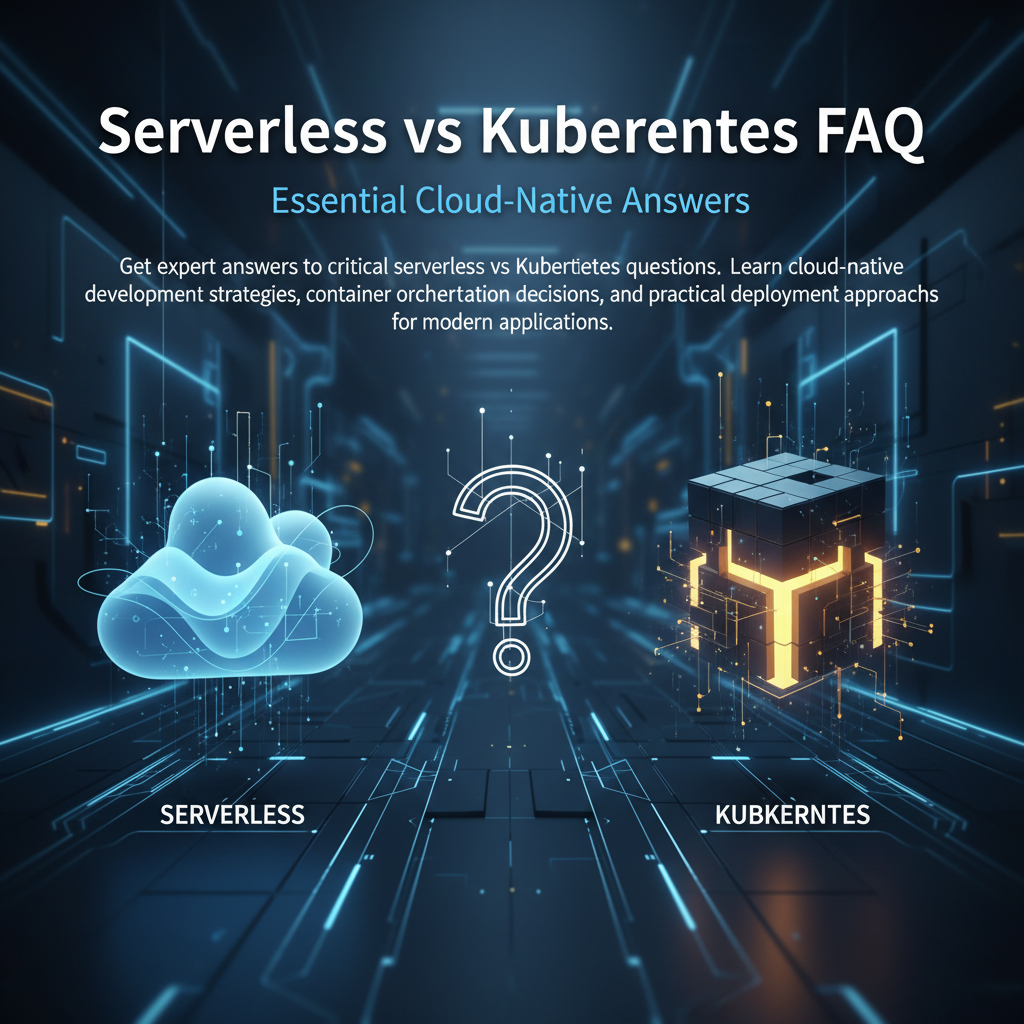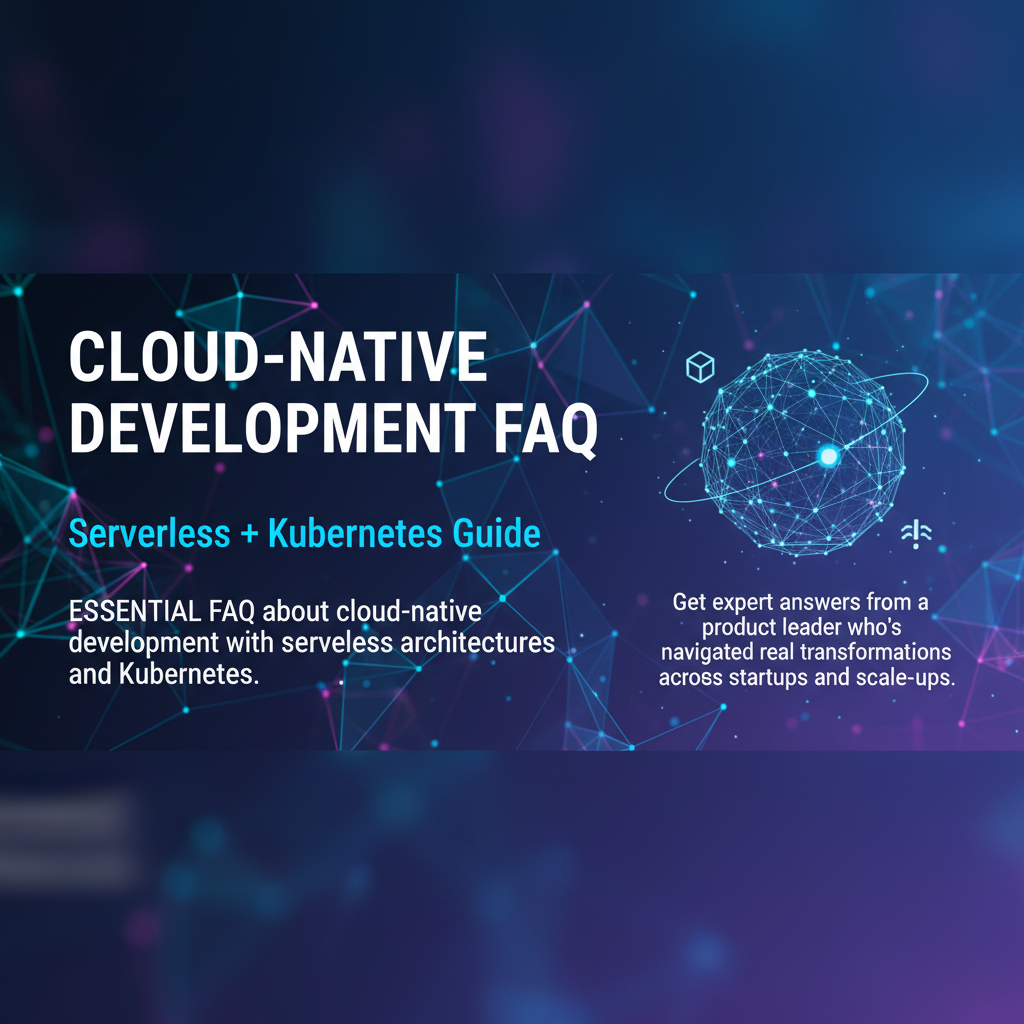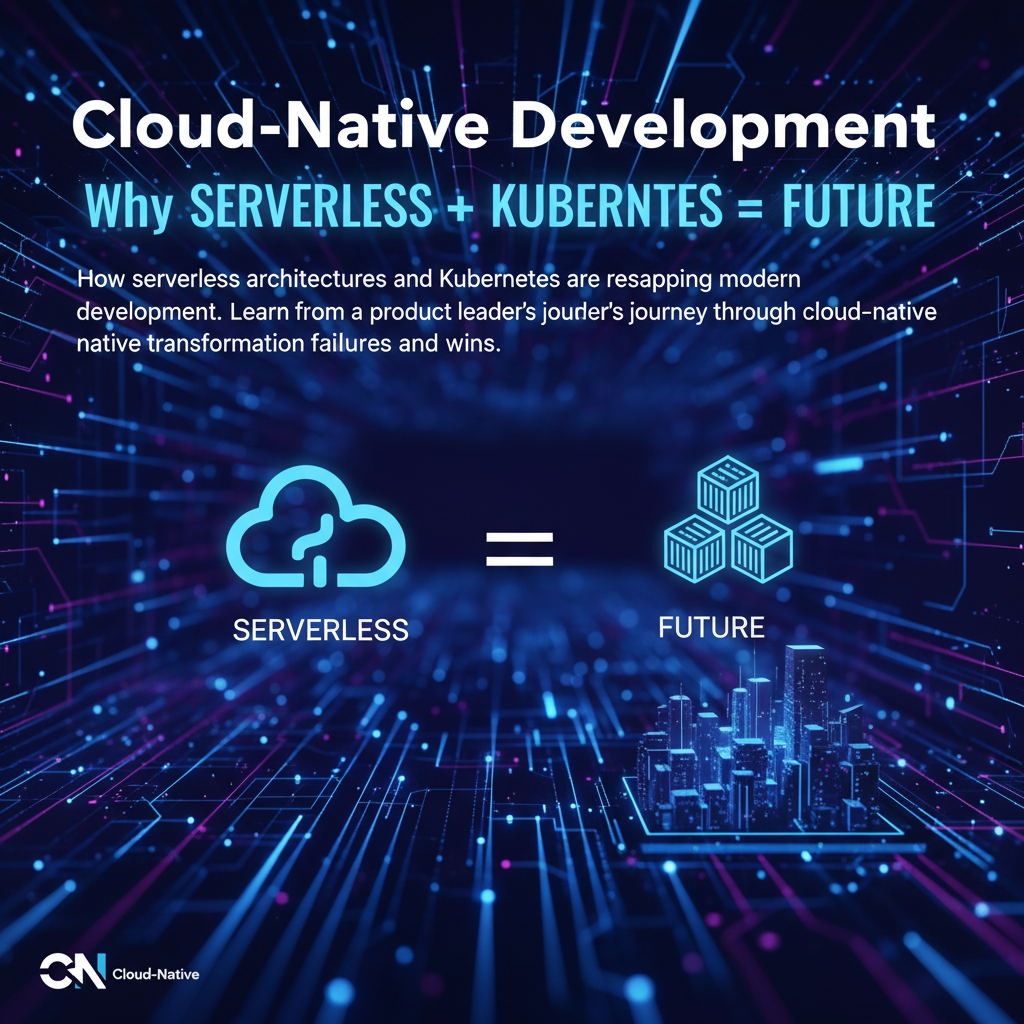Serverless vs Kubernetes: The Cloud-Native Battle Reshaping Tech
Discover how serverless architectures and Kubernetes are transforming cloud-native development. Learn practical strategies for choosing between these competing paradigms.
The Cloud-Native Revolution: Why Your Architecture Choices Define Success
Last month, I was consulting with a fintech startup whose CTO looked exhausted. "Silvia," he said, "we're burning through our runway managing infrastructure instead of building features. Our Kubernetes cluster feels like a full-time job, but everyone says serverless isn't enterprise-ready. What do we actually do?"
This conversation happens more often than you'd think. Cloud-native development has become the default approach for modern applications, but the architectural decisions—particularly between serverless architectures and Kubernetes orchestration—can make or break your product's success.
Here's the reality: 73% of organizations are running containerized applications in production, while serverless adoption has grown 300% in the past two years. Yet most teams are making these critical decisions based on hype rather than systematic evaluation of their specific needs.
The stakes couldn't be higher. Choose wrong, and you'll spend months refactoring while competitors ship features. Choose right, and you'll have the infrastructure foundation that scales with your ambitions. After 19 years of evaluating ML systems across different cloud architectures—from Booking.com's massive Kubernetes deployments to SAP's serverless experimentation—I've seen how these decisions compound over time.
In this deep dive, we'll explore the practical realities of both approaches, decode when each makes sense, and give you a framework for making this decision systematically rather than reactively. Because in cloud-native development, your architecture isn't just technical debt—it's your competitive advantage.
Serverless Architecture: The Promise of Infinite Scale with Zero Ops
Serverless architecture represents the ultimate abstraction: you write functions, cloud providers handle everything else. No servers to manage, no capacity planning, no 3 AM alerts about crashed instances. It sounds too good to be true—and sometimes it is.
The Serverless Advantage Matrix
At Booking.com, we experimented with AWS Lambda for processing booking confirmations. The results were striking: 40% faster time-to-market for new features, 60% reduction in operational overhead, and automatic scaling that handled traffic spikes without intervention.
Cost Efficiency: You pay only for execution time, not idle resources. For workloads with variable traffic patterns, this translates to massive savings. One client reduced their infrastructure costs by 70% moving from always-on containers to event-driven functions.
Development Velocity: Serverless removes infrastructure concerns from development workflows. Teams ship features instead of managing deployment pipelines. The cognitive load reduction is substantial—developers focus on business logic rather than Kubernetes YAML configurations.
Automatic Scaling: Functions scale from zero to thousands of concurrent executions without configuration. During Black Friday traffic spikes, serverless applications handle demand elastically while traditional architectures require pre-provisioned capacity.
The Hidden Complexity
But serverless isn't magic. Cold starts can add 100-500ms latency to function invocations. Vendor lock-in becomes significant when you're deeply integrated with AWS Lambda or Azure Functions. Debugging distributed serverless applications requires new tools and mental models.
Monitoring becomes crucial—and complex. Without traditional metrics like CPU and memory utilization, you need function-specific observability. Distributed tracing across hundreds of functions requires sophisticated tooling.
When Serverless Wins
Serverless excels for event-driven architectures, APIs with unpredictable traffic, and teams prioritizing development speed over infrastructure control. If you're building microservices that respond to user actions, process files, or handle webhooks, serverless provides compelling advantages.
The key is understanding that serverless isn't about eliminating servers—it's about eliminating server management from your operational concerns.
Kubernetes Dominance: Why Container Orchestration Rules Enterprise
Kubernetes has become the de facto standard for container orchestration, and for good reason. When SAP decided to modernize their enterprise applications, Kubernetes provided the control and flexibility that serverless couldn't match.
The Kubernetes Control Advantage
Kubernetes offers unprecedented control over application deployment, scaling, and resource allocation. You define desired state, and the orchestrator maintains it. This declarative approach provides predictability that many enterprises require.
Resource Optimization: Unlike serverless functions with predefined resource limits, Kubernetes allows fine-grained resource allocation. CPU and memory can be optimized per service, leading to better cost efficiency for consistent workloads.
Portability: Kubernetes applications run identically across cloud providers, on-premises data centers, and hybrid environments. This portability reduces vendor lock-in and provides strategic flexibility.
Ecosystem Maturity: The Kubernetes ecosystem includes robust solutions for monitoring (Prometheus), service mesh (Istio), and CI/CD (ArgoCD). This maturity provides battle-tested tools for complex enterprise requirements.
The Operational Reality
However, Kubernetes complexity is substantial. A typical production cluster requires expertise in networking, storage, security, and resource management. The learning curve is steep—most teams need 6-12 months to become proficient.
Operational overhead includes cluster upgrades, security patching, and resource monitoring. While managed Kubernetes services (EKS, GKE, AKS) reduce this burden, they don't eliminate it.
Performance and Predictability
Kubernetes containers don't suffer from cold start penalties. Applications maintain consistent performance characteristics, crucial for latency-sensitive workloads. Horizontal Pod Autoscaling provides predictable scaling behavior based on resource utilization or custom metrics.
For machine learning workloads—my primary domain—Kubernetes provides GPU scheduling, persistent storage, and complex workflow orchestration that serverless platforms can't match. Training models across multiple nodes requires the control that Kubernetes provides.
The Enterprise Sweet Spot
Kubernetes dominates enterprise environments because it balances control with automation. Large organizations need governance, compliance, and operational predictability. Kubernetes provides these capabilities while maintaining the flexibility to evolve architecture over time.
The platform thinking is crucial: Kubernetes isn't just container orchestration—it's a platform for building platforms. Internal developer platforms built on Kubernetes can provide serverless-like experiences for application teams while maintaining operational control.
The Systematic Decision Framework: Choosing Your Cloud-Native Path
The choice between serverless and Kubernetes isn't binary—it's contextual. After evaluating hundreds of cloud-native architectures, I've developed a systematic framework that removes guesswork from these critical decisions.
The SCALE Assessment Matrix
S - System Requirements: Evaluate latency sensitivity, throughput demands, and resource predictability. Serverless functions excel for variable workloads but struggle with consistent high-throughput scenarios. Kubernetes provides predictable performance for steady-state applications.
C - Complexity Tolerance: Assess your team's operational maturity. Serverless reduces operational complexity but increases architectural complexity. Kubernetes requires operational expertise but provides architectural simplicity.
A - Application Patterns: Event-driven, stateless workloads favor serverless. Long-running services, stateful applications, and complex workflows benefit from Kubernetes orchestration.
L - Lock-in Tolerance: Consider vendor dependency. Serverless creates deeper cloud provider integration. Kubernetes provides portability but requires more operational investment.
E - Economic Optimization: Analyze cost patterns. Variable workloads favor serverless pay-per-execution. Consistent utilization favors Kubernetes resource optimization.
Hybrid Architecture Strategies
The most sophisticated organizations don't choose exclusively. They architect hybrid solutions that leverage both paradigms strategically.
API Gateway Pattern: Use serverless functions for lightweight API endpoints while running core business logic on Kubernetes. This provides cost-effective scaling for edge cases while maintaining performance for critical paths.
Event Processing Hybrid: Kubernetes handles stream processing and stateful operations while serverless functions process individual events. This combination optimizes for both throughput and scalability.
Development Staging: Many teams use serverless for development and testing environments (lower costs, faster provisioning) while running production on Kubernetes (predictable performance, operational control).
Implementation Decision Tree
Start with workload characteristics:
- Unpredictable traffic + stateless operations → Serverless
- Consistent load + complex dependencies → Kubernetes
- Mixed patterns + mature team → Hybrid approach
- Early stage + limited ops experience → Serverless
- Enterprise requirements + compliance needs → Kubernetes
The key insight: architecture decisions compound over time. Choose based on where you'll be in 18 months, not where you are today.
When Kubernetes Almost Broke Our Team: A Cautionary Tale
Three years ago, I was advising a Series B startup that decided to migrate their entire platform to Kubernetes. The CTO was brilliant—former Google engineer, deep systems knowledge—and he was convinced that Kubernetes would solve their scaling problems.
Six months later, I got a panicked call. "Silvia, we haven't shipped a feature in eight weeks. The entire engineering team is fighting YAML files instead of building product. Our runway is burning while we debug networking issues."
The team had fallen into the Kubernetes complexity trap. What started as a migration to improve scalability had consumed all their engineering bandwidth. Junior developers couldn't deploy code without senior help. The learning curve was steeper than anyone anticipated.
We spent a weekend doing a brutal assessment. Their application was actually perfect for serverless—event-driven user interactions, unpredictable traffic patterns, stateless business logic. They'd chosen Kubernetes because it felt "more serious" and "enterprise-ready," not because it solved their actual problems.
The migration back to serverless took three weeks. Within a month, they were shipping features again. Development velocity increased 3x. The junior developers could deploy independently. The CTO later told me, "I learned that the best architecture is the one that disappears from your daily concerns."
This experience taught me that technical decisions can't be separated from team dynamics. Kubernetes might be objectively superior for certain workloads, but if it paralyzes your development process, it's the wrong choice.
The hardest part was admitting the mistake. The sunk cost fallacy is powerful—nobody wants to abandon weeks of Kubernetes configuration. But the best engineering leaders optimize for outcomes, not ego.
Now when I consult with teams, I always ask: "What architecture would let you ship the most user value in the next six months?" Sometimes that's Kubernetes. Often, it's not. The key is choosing based on your current reality, not your aspirational complexity.
Visual Guide: Kubernetes vs Serverless Architecture Patterns
Understanding the practical differences between serverless and Kubernetes architectures becomes much clearer when you see them in action. The concepts we've discussed—from container orchestration to function-as-a-service patterns—involve complex interactions that benefit from visual explanation.
This video walkthrough demonstrates real-world implementation patterns for both architectures. You'll see how Kubernetes pods communicate through services, how serverless functions chain together through event triggers, and how hybrid architectures combine both approaches strategically.
Pay attention to the deployment workflows—they reveal the operational differences that impact daily development. Notice how Kubernetes deployments require more configuration but provide more control, while serverless deployments are simpler but more opaque.
The performance comparison section is particularly valuable. You'll see cold start latencies in real-time, observe how Kubernetes horizontal pod autoscaling responds to load, and understand why certain workload patterns favor each approach.
Most importantly, watch for the decision points highlighted throughout. These are the architectural crossroads where teams often make suboptimal choices without systematic evaluation.
After watching, you'll have a much clearer mental model of how these technologies work in practice, not just in theory. This visual foundation makes the strategic decisions we've discussed much more concrete and actionable.
Building the Future: From Architecture Decisions to Product Success
The cloud-native development landscape isn't just about choosing between serverless architectures and Kubernetes—it's about building systems that amplify your team's ability to deliver value. After two decades of evaluating these technologies across different scales and contexts, the pattern is clear: the best architecture is the one that disappears from your daily concerns while enabling rapid, reliable feature delivery.
Key Takeaways for Strategic Implementation
Architecture Follows Strategy: Your cloud-native decisions should align with business objectives, not technical preferences. Serverless excels when speed-to-market and operational simplicity matter most. Kubernetes dominates when control, predictability, and complex orchestration are required.
Team Maturity Matters More Than Technology Maturity: The most sophisticated technology means nothing if your team can't operate it effectively. Factor operational expertise into architectural decisions as heavily as technical requirements.
Hybrid Approaches Win Long-Term: The most successful organizations I've worked with don't choose exclusively. They architect thoughtfully, using serverless for appropriate workloads and Kubernetes where orchestration provides clear advantages.
Economic Models Drive Adoption: Understand your cost patterns before committing. Variable workloads favor serverless economics. Consistent utilization often makes Kubernetes more cost-effective.
Vendor Lock-in Is a Strategic Decision: Don't accidentally drift into dependency. Choose your level of cloud provider integration deliberately, understanding the trade-offs between convenience and portability.
The challenge is that most teams make these critical architectural decisions reactively, driven by immediate pain points rather than systematic evaluation. This reactive approach leads to the infrastructure chaos I see repeatedly: teams spending more time managing their architecture than building features.
The Real Problem: Vibe-Based Development
Here's what I've learned after consulting with hundreds of engineering teams: the architecture decision is just the symptom. The real problem is "vibe-based development"—making critical technical choices based on what feels right rather than systematic analysis of requirements, constraints, and trade-offs.
This pattern extends far beyond infrastructure. Teams choose frameworks based on buzz, prioritize features based on assumptions, and architect systems based on what worked somewhere else. The result? 73% of features don't drive meaningful user adoption, 40% of engineering time gets spent on the wrong priorities, and teams constantly react to symptoms rather than addressing root causes.
The scattered nature of technical decision-making compounds this problem. Architecture discussions happen in Slack threads. Requirements live in different documents. User feedback sits in support tickets while engineering decisions get made in isolation. Teams lack the systematic intelligence needed to align technical choices with business outcomes.
Introducing Systematic Product Intelligence
This is exactly why we built glue.tools as the central nervous system for product decisions. While teams debate serverless versus Kubernetes in meetings, they're missing the deeper question: how do we systematically connect user needs to technical implementation?
glue.tools transforms scattered feedback—from sales calls, support tickets, user interviews, and analytics—into prioritized, actionable product intelligence. Our AI-powered system aggregates insights from multiple sources, automatically categorizes and deduplicates requests, then applies a 77-point scoring algorithm that evaluates business impact, technical effort, and strategic alignment.
But here's where it gets powerful for cloud-native development: instead of making architecture decisions in isolation, you can see exactly how serverless versus Kubernetes choices impact your ability to deliver the features users actually need. The system provides department sync with automated distribution to relevant teams, including the technical context and business rationale that engineering leaders need.
Our 11-stage AI analysis pipeline thinks like a senior product strategist, replacing architectural assumptions with specifications that actually compile into profitable products. You get complete output: PRDs that address real user needs, user stories with acceptance criteria, technical blueprints that inform your cloud-native decisions, and interactive prototypes that validate approaches before major infrastructure commitments.
This front-loads clarity so teams build the right thing on the right architecture faster, with less drama. What typically takes weeks of requirements gathering, architecture debates, and alignment meetings gets compressed into about 45 minutes of systematic analysis.
The platform works in both Forward Mode ("Strategy → personas → JTBD → use cases → stories → schema → screens → prototype") and Reverse Mode ("Code & tickets → API & schema map → story reconstruction → tech-debt register → impact analysis"). This means whether you're planning new cloud-native architecture or evaluating existing systems, you have continuous alignment through feedback loops that parse changes into concrete edits across specs and implementation.
Companies using this systematic approach to product intelligence see an average 300% ROI improvement. They prevent the costly rework that comes from building based on vibes instead of specifications. It's like having Cursor for PMs—making product managers 10× faster the same way code assistants revolutionized development.
Hundreds of companies and product teams worldwide now trust this systematic approach to move from reactive feature building to strategic product intelligence. Instead of debating serverless versus Kubernetes in the abstract, they make architecture decisions that directly support validated user needs and business outcomes.
Ready to move beyond vibe-based development? Experience how systematic product intelligence transforms not just your architecture decisions, but your entire approach to building products that users actually want. Generate your first PRD, experience the 11-stage analysis pipeline, and discover what it feels like when technology choices serve validated user needs rather than technical preferences.
The future belongs to teams that think systematically. Your architecture should amplify that advantage, not obstruct it.
Frequently Asked Questions
Q: What is serverless vs kubernetes: the cloud-native battle reshaping tech? A: Discover how serverless architectures and Kubernetes are transforming cloud-native development. Learn practical strategies for choosing between these competing paradigms.
Q: Who should read this guide? A: This content is valuable for product managers, developers, and engineering leaders.
Q: What are the main benefits? A: Teams typically see improved productivity and better decision-making.
Q: How long does implementation take? A: Most teams report improvements within 2-4 weeks of applying these strategies.
Q: Are there prerequisites? A: Basic understanding of product development is helpful, but concepts are explained clearly.
Q: Does this scale to different team sizes? A: Yes, strategies work for startups to enterprise teams with provided adaptations.



